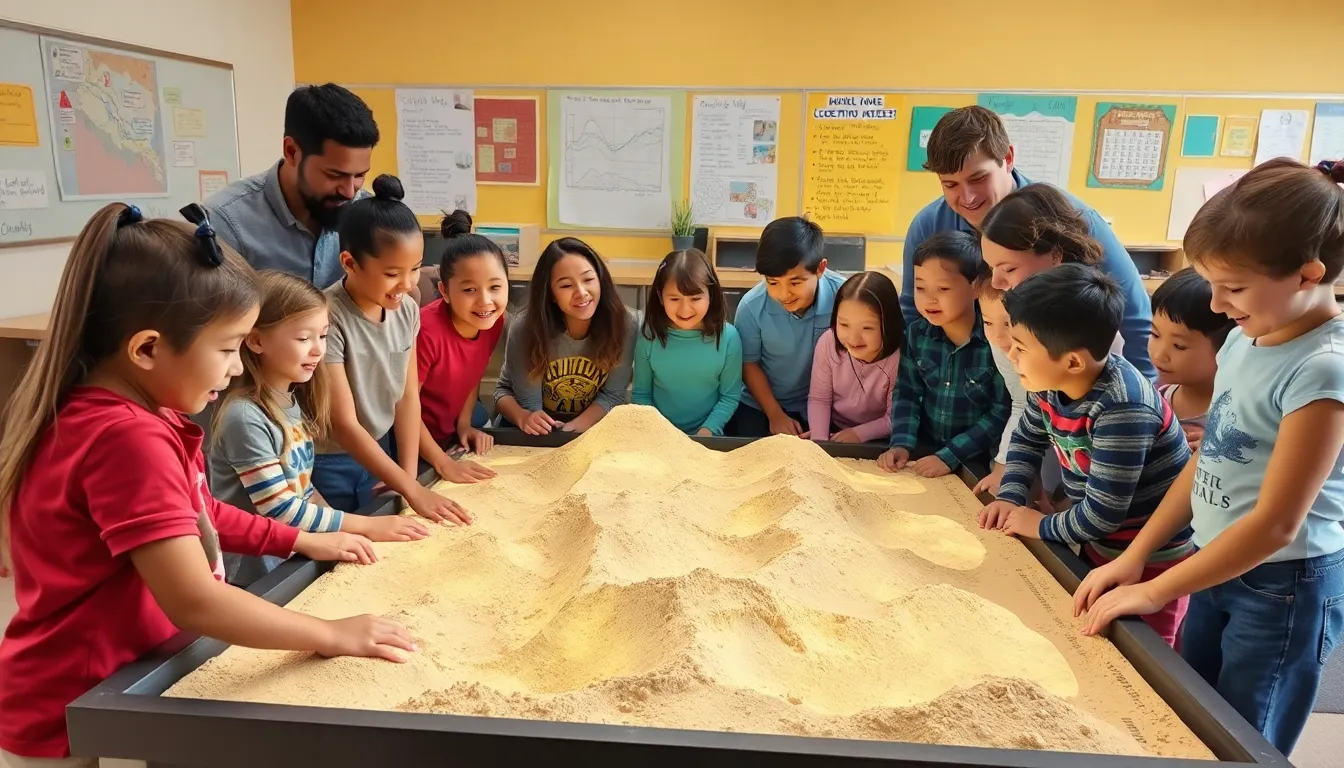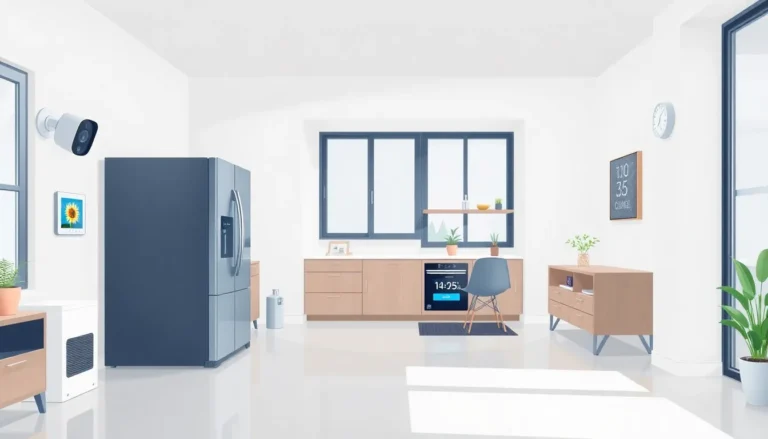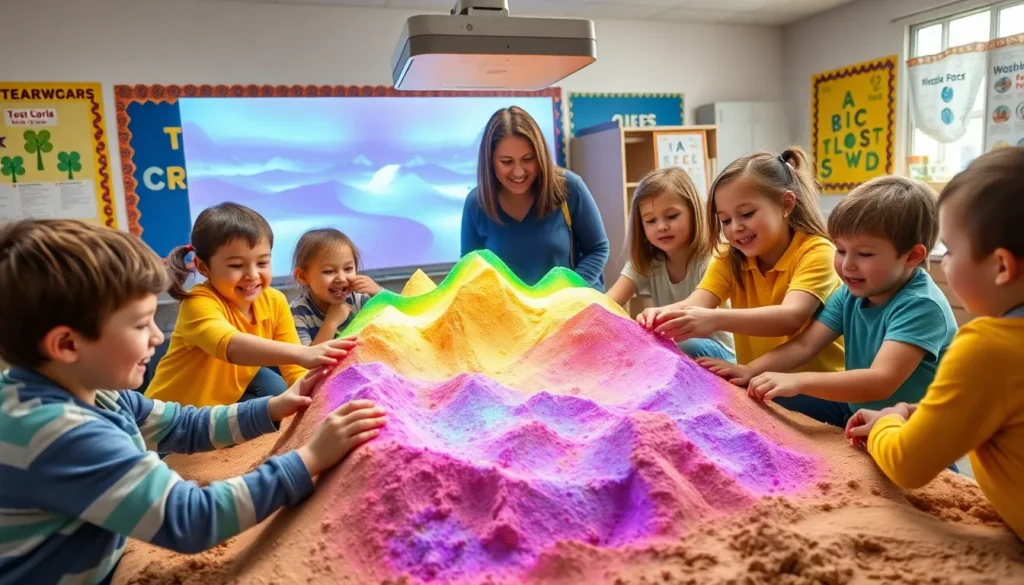Table of Contents
ToggleImagine a world where playing in the sand isn’t just for kids at the beach. Enter the augmented reality sandbox, a playful fusion of technology and creativity that transforms a simple pile of sand into a vibrant landscape. With a sprinkle of digital magic, users can sculpt mountains, rivers, and valleys while watching real-time topographical changes right before their eyes.
Overview of Augmented Reality Sandbox
An augmented reality sandbox offers an interactive platform where creativity meets technology. Users engage with real sand to sculpt terrains such as hills and valleys. Digital overlays enhance this experience, providing visual feedback on topographical changes.
Visual effects react to users’ manipulations in real-time. When they raise or lower the sand, the system adjusts colors and textures to reflect water levels or vegetation growth. This process transforms simple play into an educational tool, demonstrating geological concepts and environmental processes.
Installation typically involves a projector and a depth-sensing camera. The camera tracks the sand’s surface while the projector displays graphics onto it. This setup creates an immersive atmosphere that captivates users of all ages.
Educational institutions frequently use augmented reality sandboxes for teaching purposes. Subjects like geography, ecology, and physics become engaging through hands-on interactions. Workshops and camps often employ this technology to foster learning in a fun manner.
Development continues to evolve, with new software updates and features regularly enhancing the user interface. Improvements in projection quality and depth sensing enhance accuracy, allowing for more detailed representations of landscapes. Augmented reality sandboxes contribute to innovative learning experiences, promoting critical thinking through creative exploration.
How Augmented Reality Sandbox Works

Augmented reality sandboxes combine real sand and digital technology, enabling interactive and educational experiences. Users manipulate sand to create landscapes while visual feedback reflects topographical changes in real time.
Technology Behind the Sandbox
Advanced technology powers these sandboxes, with a depth-sensing camera tracking the sand’s shape. Projection systems display graphics that overlay the real-world sand. This synchronization creates a seamless experience where users see immediate visual results from their actions. Users sculpt hills and valleys, promoting an understanding of geographical concepts. Enhanced algorithms improve depth perception and responsiveness, ensuring accurate terrain representation.
Key Features and Components
Essential components include a projector, which displays visuals, and a depth-sensing camera, which accurately measures the sand’s topography. Many systems incorporate a computer to process data and manage graphics. Interactive features often allow users to engage with simulated environmental elements like water or vegetation. Educational functions support learning across various subjects, making these sandboxes valuable in classrooms and workshops. User-friendly designs facilitate engagement for all ages, encouraging exploration and creativity.
Applications of Augmented Reality Sandbox
Augmented reality sandboxes find diverse applications across various fields, enhancing both learning and entertainment.
Educational Uses
Educational institutions leverage augmented reality sandboxes to teach geography, ecology, and physics. Interactive simulations allow students to visualize concepts like erosion and water flow. Engaging activities promote hands-on learning, helping students grasp complex ideas. During lessons, students can create landscapes that demonstrate real-world environmental processes. Teachers often incorporate these sandboxes into curricula, fostering enthusiasm for learning. Workshops that focus on STEM subjects utilize the technology for collaborative projects, enhancing teamwork and problem-solving skills. This innovative approach results in improved retention of information and deeper understanding of environmental science.
Entertainment and Gaming
Augmented reality sandboxes also serve as a unique entertainment platform. Families and friends gather to enjoy creative play, manipulating sand to form imaginative landscapes. Users experience interactive challenges that blend physical play with digital overlays, increasing engagement. Game developers explore this technology for immersive experiences, setting new standards in the gaming industry. Users can undertake quests that involve building and managing virtual environments, all while interacting with a real sand surface. Events and exhibitions frequently feature augmented reality sandboxes, captivating audiences with their dynamic visual effects. The blend of creativity and technology elevates leisure activities, making them enjoyable for all ages.
Benefits of Augmented Reality Sandbox
Augmented reality sandboxes offer numerous advantages, enhancing both education and entertainment. Educational experiences thrive with the use of interactive simulations that teach geological concepts, such as erosion and water flow. Motivation increases as students engage in hands-on learning, leading to improved retention of information.
Interactive play cultivates creativity while users mold real sand into imaginative landscapes. Digital effects enhance this experience by providing immediate visual feedback on changes in terrain, making abstract concepts more tangible. Users benefit from instant adjustments in colors and textures, which illustrate environmental processes in real-time.
Collaboration stands out as a key component in learning. Students work together on projects, fostering teamwork and communication skills. Teachers find these sandboxes useful for effectively engaging students in STEM subjects, creating a stimulating environment that encourages exploration and inquiry.
Families and friends also experience the joy of augmented reality sandboxes. Fun emerges as they combine physical interaction with digital elements, promoting shared moments of creativity. Unique gaming opportunities arise as developers explore the technology, offering immersive experiences that allow users to build virtual environments while interacting with actual sand.
Exhibitions and events showcase this innovative technology, captivating audiences with dynamic visual displays. Spectators appreciate the blend of science and art, further promoting interest in environmental education. The continuous evolution of augmented reality sandboxes, including software updates and enhanced projection quality, ensures that users enjoy an accurate and engaging experience.
Overall, augmented reality sandboxes revolutionize how learning takes place and how individuals engage in creative play. These benefits underscore the importance of integrating technology in educational settings and entertainment platforms.
Challenges and Limitations
Augmented reality sandboxes face several challenges that can impact their effectiveness. One significant limitation is the requirement for space. Installation necessitates a dedicated area to accommodate both the sandbox and the projection equipment. Users without sufficient space may struggle to utilize this technology.
Hardware costs represent another hurdle. High-quality projectors and depth-sensing cameras can be expensive, placing augmented reality sandboxes out of reach for some educational institutions and organizations. Budget constraints often limit access to this engaging technology.
Maintenance also poses challenges. The complex setup requires regular updates and calibrations to maintain performance. Neglecting maintenance can lead to inaccuracies in projection and responsiveness, affecting the user experience negatively.
User experience can be further complicated by technical issues. Software glitches and equipment malfunctions detract from the immersive experience that these sandboxes aim to provide. Technical support and troubleshooting may also require expertise that not all users possess.
Scalability issues can arise as well. For larger groups, the sandbox may not accommodate many users simultaneously. This limitation can hinder collaborative learning experiences that enhance engagement and interaction.
Finally, the need for educational training exists. Educators may require instruction on effectively integrating augmented reality sandboxes into curricula. Without proper training, the potential of these tools to enhance learning and creativity may remain untapped.
Future of Augmented Reality Sandbox
Future developments in augmented reality sandboxes promise enhanced engagement and interactivity. Innovations in depth-sensing technology will improve real-time feedback, making simulations more intuitive. Software updates will continue to refine visual effects, offering more realistic representations of landscapes.
In education, augmented reality sandboxes are expected to integrate more educational frameworks, fostering an interdisciplinary approach to learning. Teachers across various subjects will utilize these tools to create dynamic environments that illustrate complex scientific mechanisms. Collaboration among educators will enhance instructional strategies, broadening the scope of curriculum integration.
Expanding applications in entertainment present exciting possibilities. Game developers will leverage augmented reality sandboxes to create immersive experiences that enrich gameplay. Families and friends will enjoy new forms of interactive entertainment, blending physical and digital play like never before.
Business interests may also grow, leading to commercial adaptations of this technology. Companies will explore augmented reality sandboxes for team-building exercises and marketing installations. Such ventures could drive innovation and create unique ways for organizations to engage with their audiences.
Accessibility remains a key consideration. Advancements in mobile technology and compact projection systems may increase the reach of augmented reality sandboxes in educational institutions. Efforts to reduce hardware costs and maintenance challenges will encourage wider adoption.
Optimizing training programs for educators could also enhance the effective use of these tools. Professional development initiatives will empower teachers to confidently incorporate augmented reality sandboxes into their lesson plans. Through ongoing advancements and dedicated training, these sandboxes will transform education and entertainment alike.
Augmented reality sandboxes represent a groundbreaking fusion of technology and creativity. They not only enhance play but also serve as powerful educational tools that engage users in interactive learning experiences. As technology advances, these sandboxes are set to become even more immersive and accessible, broadening their applications in both education and entertainment.
While challenges exist, such as installation costs and maintenance, the potential benefits far outweigh the drawbacks. By fostering collaboration and creativity, augmented reality sandboxes can transform how people interact with their environment. The future looks bright for this innovative technology, promising exciting developments that will continue to captivate users of all ages.







